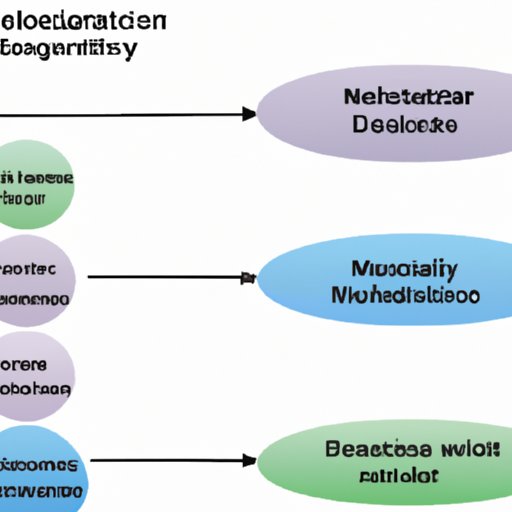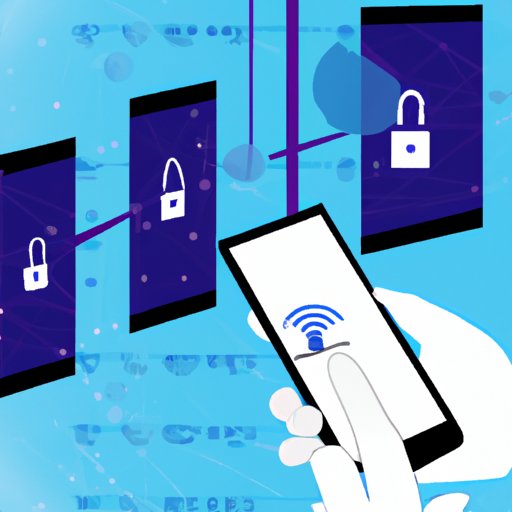Introduction
Mobile data is a form of internet access that is provided through wireless technology. It allows users to connect to the internet from any location, regardless of whether they are in an area with traditional wired infrastructure or not. Mobile data is used by businesses, consumers, and government agencies to access information, stay connected, and conduct transactions.
The purpose of this article is to explore how mobile data works. We will look at the basics of how it works, the technologies behind it, the different types of services available, the benefits and drawbacks of using it, and the security considerations for mobile data usage.

Exploring the Basics of How Mobile Data Works
Before we dive into the specifics of how mobile data works, let’s take a look at the overall architecture of a mobile network. A mobile network consists of four main components: base stations, mobile switches, mobile devices, and the communication network. The base stations are responsible for transmitting and receiving signals from the mobile devices. The mobile switches are responsible for routing calls and data between the base stations and the communication network. The communication network is the backbone of the system and is responsible for connecting the base stations to each other and to the public switched telephone network (PSTN). Finally, the mobile devices are the end-user devices that are used to initiate and receive calls and data transmissions.
Now that we have an understanding of the overall architecture of a mobile network, let’s take a look at how mobile data is transmitted. Mobile data is transmitted over radio frequencies using multiplexing techniques such as frequency division multiplexing (FDM) and time division multiplexing (TDM). FDM divides the available radio spectrum into multiple channels, each carrying a different type of data. TDM assigns a specific time period for each channel to transmit its data. Once the data is transmitted, it is received by the base station and routed to the appropriate destination.

An Overview of the Technologies Behind Mobile Data
Now that we understand the basics of how mobile data works, let’s take a look at the technologies behind it. There are three primary technologies that make up the mobile data landscape: cellular networks, wireless broadband connections, and satellite connections.
Cellular Networks
Cellular networks are the most common type of mobile data technology. They use a combination of radio towers and base stations to provide coverage to a wide area. Cellular networks are divided into two categories: Global System for Mobile Communications (GSM) and Code Division Multiple Access (CDMA). GSM is the most widely used cellular network technology, while CDMA is more popular in North America.
Wireless Broadband Connections
Wireless broadband connections are another type of mobile data technology. These connections use radio waves to provide high-speed internet access. They are typically used in areas where traditional wired infrastructure is either unavailable or too expensive to deploy. Wireless broadband connections are usually offered by internet service providers (ISPs) and can be purchased separately or bundled with other services.
Satellite Connections
Satellite connections are the third type of mobile data technology. These connections use satellites to provide coverage to remote areas where other types of infrastructure are unavailable. Satellite connections are often used in areas where cellular networks are not available or are not reliable enough to provide consistent coverage.
Understanding the Different Types of Mobile Data Services
Now that we have an understanding of the technologies behind mobile data, let’s take a look at the different types of services available. The most common types of mobile data services are voice calls, text messaging, internet access, and streaming services.
Voice Calls
Voice calls are the most basic type of mobile data service. They allow users to make and receive phone calls using their mobile device. Voice calls are typically provided through cellular networks and are billed on a per-minute basis.
Text Messaging
Text messaging is another type of mobile data service. It allows users to send and receive text messages using their mobile device. Text messaging is typically provided through cellular networks and is billed on a per-message basis.
Internet Access
Internet access is the third type of mobile data service. It allows users to access the internet from their mobile device. Internet access is typically provided through cellular networks, wireless broadband connections, or satellite connections and is billed on a per-megabyte basis.
Streaming Services
Streaming services are the fourth type of mobile data service. They allow users to stream audio and video content from the internet using their mobile device. Streaming services are typically provided through cellular networks, wireless broadband connections, or satellite connections and are billed on a per-month or per-usage basis.
Examining the Benefits and Drawbacks of Using Mobile Data
Now that we have an understanding of the different types of mobile data services, let’s take a look at the benefits and drawbacks of using mobile data.
Advantages
The primary advantage of using mobile data is that it allows users to stay connected no matter where they are. This makes it ideal for people who need to stay connected while traveling or living in remote areas. Mobile data also helps reduce costs by eliminating the need for wired infrastructure, such as phone lines or internet cables.
Disadvantages
The primary disadvantage of using mobile data is that it can be expensive. The cost of mobile data services can add up quickly, especially if you’re using a lot of data. Mobile data also tends to be slower than wired connections, and the quality of service can vary depending on your location. Additionally, mobile data services are subject to network outages, which can disrupt your connection.

Investigating the Security Considerations for Mobile Data Usage
Finally, let’s take a look at the security considerations for mobile data usage. Mobile data is inherently less secure than wired connections because it is transmitted over the airwaves. To protect your data, it is important to use encryption, authentication, and firewalls. Encryption scrambles your data so that only authorized users can view it. Authentication ensures that only authorized users can access your data. And firewalls act as a barrier between your data and potential attackers.
Conclusion
In conclusion, mobile data is an essential technology for staying connected and accessing the internet. It is powered by a variety of technologies, including cellular networks, wireless broadband connections, and satellite connections. There are a variety of services available, including voice calls, text messaging, internet access, and streaming services. Mobile data has both advantages and disadvantages, and it is important to consider the security implications before using it.
Summary
This article explored how mobile data works. We looked at the basics of how it works, the technologies behind it, the different types of services available, the benefits and drawbacks of using it, and the security considerations for mobile data usage. By understanding these concepts, you can make informed decisions about how best to use mobile data.
Recommendations
If you plan to use mobile data, it is important to consider the security implications. Make sure to use encryption, authentication, and firewalls to protect your data. Additionally, research the different services available and choose the one that best fits your needs. By taking these steps, you can ensure that you get the most out of your mobile data experience.
(Note: Is this article not meeting your expectations? Do you have knowledge or insights to share? Unlock new opportunities and expand your reach by joining our authors team. Click Registration to join us and share your expertise with our readers.)
